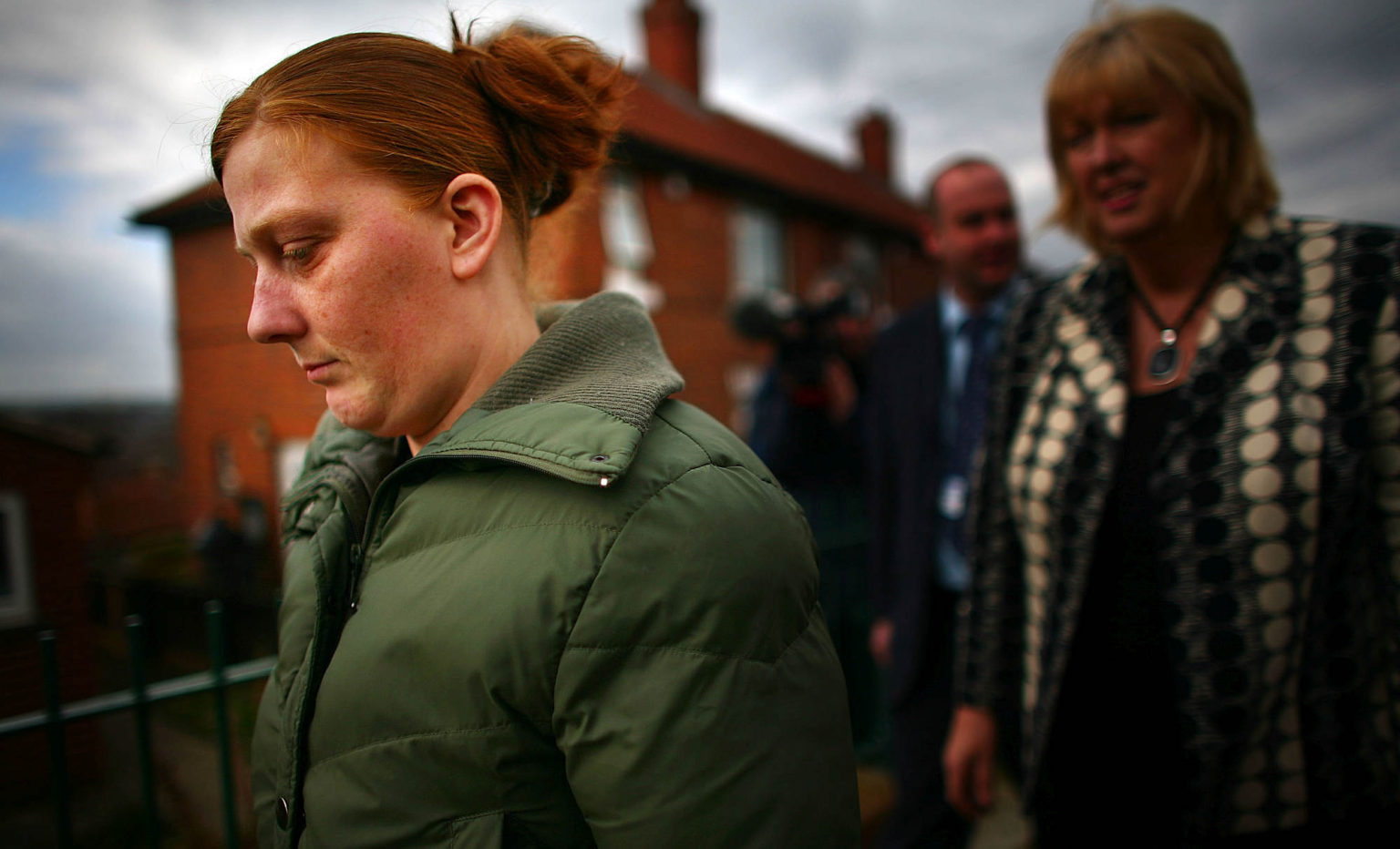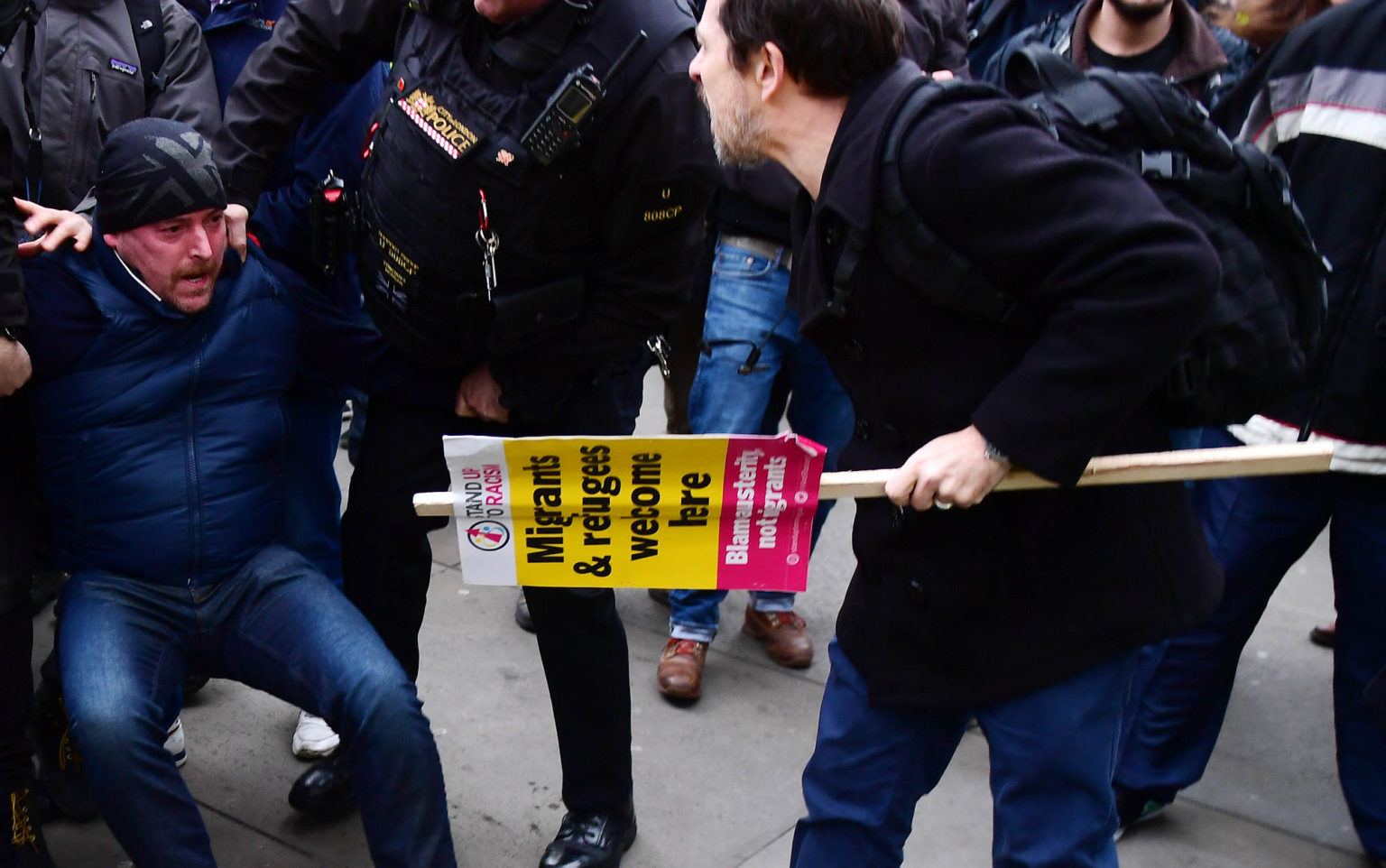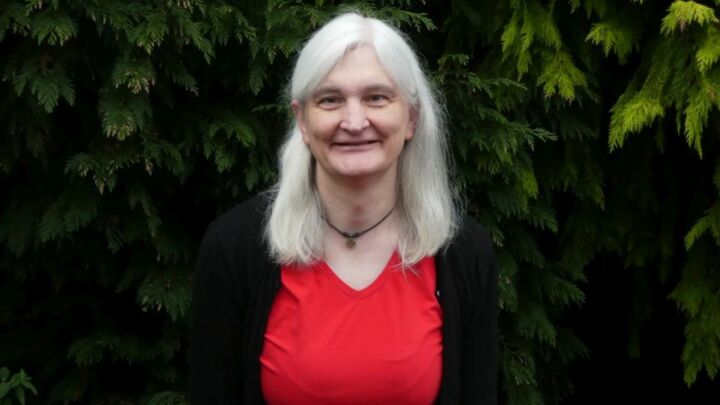
Long-read
The stigmatisation of the working class
From right to the left, caricatures of working-class life abound.
The following is an edited extract from Stigma, and its Discontents, by Ken McLaughlin
UK council estates have long been stigmatised. They are seen as places populated by what right-wing political scientist Charles Murray refers to as the ‘underclass’. Places in which unemployment, poverty and associated problems are recast as cultural issues rather than economic or political ones.
One prominent example of such stigmatisation was the pejorative term ‘chav’, which entered public discourse in the early 2000s. It referred to a type of anti-social, uneducated young person wearing certain kinds of clothing. It was later used by some as an acronym for ‘council housed and violent’.
The image of the chav in the media, with shows such as Little Britain to the fore, brings to life the fear of ‘them’ – the uncivilised hordes threatening and draining civil society. Mainstream journalists often frame the most extreme characters within working-class communities as representing an entire demographic. Take the case of Karen Matthews, whose daughter Shannon went missing in February 2008. This sparked a huge manhunt, only for it to transpire that Matthews had herself hidden her in the hope of gaining some reward money. Matthews was referred to in the Observer as ‘representative of a feckless underclass, a broken society, a generation of parents only concerned for their own childish emotions’. In a similar vein, a leader column in the Daily Express opined that ‘the poor’ were simply the ‘Karen Matthews brigade… able to make welfare dependency a career choice, churning out children they have no intention of supporting’ (1).
In Chavs: The Demonisation of the Working Class, journalist Owen Jones discussed the different media responses to the disappearance of Madeleine McCann in May 2007 and Shannon Matthews in February 2008. The former generated three times as much media coverage as the latter. Two weeks after each abduction, the money raised to help find them was £2.6million for Madeleine but only £25,000 for Shannon. Many politicians, celebrities and journalists went public to voice their hopes that Madeleine would be found alive and well; very few did the same for Shannon.
In attempting to explain this disparity Jones notes how the McCanns were middle-class professionals, photogenic and regular churchgoers, representing an almost ideal portrait of middle-class life. The Matthews family were almost the polar opposite. Shannon’s mother had seven children to five different men, did not work, and looked unkempt in cheap clothing. For the middle-class media she was not ‘one of us’.
Of course, it transpired that Matthews was indeed an awful person. As stated, Shannon was found alive and well. Her mother and her boyfriend had drugged and kidnapped her in the hope of getting some reward money.
But rather than Matthews being seen as an aberration, she quickly became representative of an entire demographic in media portrayals of the inhabitants of working-class council estates. As Jones points out, the case of the serial killer GP Harold Shipman rightly generated much disgust, but it did not lead to all doctors being portrayed as morally depraved.
In demonising the estate in Dewsbury, West Yorkshire, that Karen Matthews lived on as populated by a feral underclass who ‘breed for greed’, as one Conservative councillor put it, the media had to ignore some aspects of the case that did not fit their narrative. They ignored, for example, how the local community had come together to help look for Shannon, carrying out searches themselves, and digging into their own pockets to help fund the appeal.

It seems that the worst examples of working-class people are often portrayed as the norm. The creators of Little Britain, Matt Lucas and David Walliams, did get some criticism for being two privately educated and wealthy men portraying caricatures of working-class life. But speaking in their defence, Lucas said: ‘If the observation rings true and is funny, then why should it matter who is making the observation?’ For the journalist Richard Littlejohn, ‘Matt Lucas and David Walliams’ Burberried chavs captured perfectly the gruesome reality of so much of our modern landscape’ (2). Such sentiments are not uncommon in certain circles. It seems that many middle-class media commentators regard those who inhabit council estates as barbarians at the gate, a mass to be feared lest they infect ‘respectable’ society.
In 2020, an increase in cultural sensitivities to race and the increasing prominence of transgender politics and ideology in mainstream outlets, led to Lucas and Walliams apologising for characters on their earlier shows. They expressed regret for making fun of ethnic identities, ‘blacking up’, and for their mocking portrayal of two transvestites. They were keen to state that they would not be bringing those characters back in any subsequent series. However, it was striking that there were no calls for an apology – nor did the comedians feel any need to apologise – for the grotesque caricature of working-class mothers in their character Vicky Pollard.
Even sympathetic portrayals of working-class life, such as Paul Abbot’s semi-autobiographical television series Shameless, which depicts a family living on welfare benefits and having lots of sex, can further entrench negative attitudes. As critics have pointed out, while amusing and generally sympathetic to the characters, Shameless fails to offer any discussion, for example, of de-industrialisation and loss of employment, to show how the characters got into the situation they are in. Instead, poverty is seen as simply a lifestyle choice by the ‘feckless’ poor. In other words, it risks naturalising a situation that actually resulted from sociopolitical change.
Weaponising stigma
In portraying the worst examples of the poor working class as the norm, and failing to look behind the lifestyles of the inhabitants of council estates, class is not portrayed as a social relationship but as an identity – and, for the poorest sections of society, the underclass or the precariat, it is treated as an identity they have chosen for themselves and are happy to wallow in.
The portrayal of the poor as an underclass also racialises them. Their behaviour and material deprivation are seen as partly hereditary, a behavioural pathology transmitted from one generation to the next. For many on the contemporary left, this is all a form of ‘poisonous class bile’, a type of ‘social racism’.
However, this obscures the discursive force of the stereotype. For this often vitriolic portrait not only naturalises poverty. It also legitimates ‘the social abjection of the most socially and economically disadvantaged citizens within the state’ (3).
Moreover, as sociologist Loïc Wacquant argues, it would be a mistake to view the stigmatisation of the working class solely as a product of policies that marginalise specific groups, such as asylum seekers and the unemployed. It is a process, rather, that entrenches and legitimises inequalities and injustice. It allows for the urban poor to be expelled ‘to the margins and crevices of social and physical space’ (4).
In short, this is what the sociologist Graham Scambler calls the ‘weaponising of stigma’. Shame and blame are combined in such a way that the poor can be seen as architects of their own plight and therefore ignored. The stigmatisation, indeed the constant degradation of the working class, whether in the vitriolic form of many politicians and media commentators or in the more humorous portrayals of comedians, helps to pave the way for extending controls over the poorest sections of society.
Given how pivotal social class is to life chances and precarious living, it is remarkable the extent to which it is missing from contemporary political debate. Of course, references are there if you look for them, but this only substantiates the point. In previous decades, class and class conflict featured highly in public and political discussion. Today, by contrast, the language of class struggle has been effectively jettisoned from political discourse, or, as discussed above, class is seen as an identity rather than a social relation.
Many academics and commentators blame right-leaning politicians, social commentators and the media for the exclusion of class from political discourse. But it is not only those on the right who are responsible for this development. Many who see themselves as left-leaning progressives have also helped to cultivate a political climate in which an understanding of class has reduced resonance. The turn to identity politics and fights over cultural recognition, while often having radical roots, can be just as guilty of neglecting class relations and analysis. Identitarian activists may want to improve opportunities and conditions for a particular group. But such an objective does not improve the lot of society as a whole. In this way, many of the proponents of identity politics actually help to consolidate capitalism. The process of exploitation can continue unabated, provided each group is equally exploited.
Stigmatising the public
Today, those who consider themselves politically and socially progressive are at pains to ensure that no stigma is attached to people on account of certain attributes, most notably around race, gender, sexuality and disability. Yet as the ‘chav’ phenomenon shows, such respect is often lacking in relation to those in the lower echelons of class society. The stereotyping of certain groups of people in the past fostered a sense of superiority in those doing the othering. This would mean, for example, that white people would have a higher status than black people, men than women, heterosexuals than homosexuals. Today, while the targets may be different, the rhetoric is often very similar. And strikingly, such sentiments are often as likely to come from those who consider themselves on the left of the political spectrum as it is from those on the right.
Sadly, respect for society’s disadvantaged is often lacking in the minds of those who, ostensibly, claim to be on their side. It is easy to form the opinion that such activists prefer to speak for the working class rather than to them. Their respect is for people as victims in need of activist benevolence. When working-class people do voice their anger with how things are, or engage in the democratic process to change the status quo, activist respect can soon become barely disguised disdain if the engagement and expression take a different form to that favoured by the activists themselves.

Perhaps the most striking example of this form of acceptable intolerance in recent years was the reaction to those who voted Leave in the 2016 EU referendum. Following the result, Leave voters found themselves under attack by many commentators who consider themselves liberal-minded. Leave voters were characterised as being driven by anti-immigrant racism and as lacking the educational ability to understand what was at stake in the referendum or the advantages that membership of the EU bestowed upon them. According to the then Labour MP Chuka Umunna, chair of the All Party Parliamentary Group on Social Integration, there had been a ‘demonisation of immigrants’ due to the ‘poisonous tone of the debate during the EU referendum campaign and after’, and ‘we must act now to safeguard our diverse communities from the peddlers of hatred and division’. The implication here is that those who voted Leave were duped by the anti-immigrant rhetoric of certain campaigners, and that a latent hatred of foreigners is in danger of being unleashed unless steps are taken to safeguard immigrant communities.
According to Miqdaad Versi, director for media monitoring at the Muslim Council of Britain, the result seemed to have ‘unleashed a Pandora’s box of bigotry and Islamophobia’. Like Umunna, he apportions blame to ‘the political elite’, who stoked ‘a divisive referendum campaign that demonised immigrants by spreading fictitious scare stories, all the while pandering to the lowest common denominator’. For Antonia Bright of the Movement for Justice, ‘Brexit is the outcome of the decrepit, unrelenting racist scapegoating of immigrants by politicians right here, over decades’. Veteran Labour MP Diane Abbott declared that, ‘The Brexit vote, whatever you think of that vote, has added another turn of the screw to rising racism’.
It quickly became clear that many of those who occupy the nation’s decaying deindustrialised zones had voted to leave the EU. Far from attempting to understand why this was the case, many of those who voted to remain began their own process of demonisation. An all-too common conclusion was that the atavistic white working-class are too stupid to recognise their own economic best interests, and, even worse, they seem to be dedicated to the task of tearing down all the achievements of multiculturalism.
In the foreword to their book The Rise of the Right (2017), which analyses why significant sections of the white working-class have rejected the Labour Party, Simon Winlow and Steve Hall summarise the political establishment’s incredulity at the result of the referendum:
‘Didn’t [the Leave voters] see the great benefits of cultural diversity? How could they not be sympathetic towards the millions of people who had left their countries of origin to journey thousands of miles in search of something better?
‘The nation was in the grip of a new and virulent form of racism, the liberal commentariat claimed, and regressive elements among the old white working-class were its driving force. Guileless proletarians had been duped by career politicians who had played on and exacerbated an extant cultural antagonism towards the non-white population… The white working-class, quite clearly, had fallen victim to dark forces keen to stir up racism and xenophobia. A new age of stupidity and blind prejudice was beginning to emerge.’ (5)
Indeed, even some commentators generally aware of the problems of stereotyping were at pains to link pro-Brexit campaign tactics to a hatred of foreigners and even to murder. For example, the sociologist Imogen Tyler discussed a poster campaign by UKIP which implied that the country was being swamped by non-white immigrants, and how, within hours of the launch of the poster campaign, the pro-EU Labour MP Jo Cox had been murdered in the street by a white nationalist. The implication was clear: the killing of Cox was not an isolated tragedy, but an extreme manifestation of a dangerous mob mentality. For Tyler, across Europe ‘the resurgence and amplification of fascist ideologies, practices and policies is evident on every scale and in every sphere of social life’ (6).
This kind of commentary is meant to imply that holding pro-EU sentiments puts one on a higher moral plane than the ‘anti-foreigner bigots’ who voted for Brexit. This conveniently overlooks the fact that the EU is not actually in favour of freedom of movement, otherwise we would not have all those people drowning in the Mediterranean Sea. It was the EU that built ‘Fortress Europe’, a variety of legal, bureaucratic and physical barriers to non-Europeans, those ‘others’. For many supporters of the EU, the dominance of the fallacy of free movement no doubt helps to soothe their moral conscience – they can demonise their political opponents while ignoring the plight of those considered not a part of us, not European.
We saw a similar stigmatisation at work during the Covid pandemic. In June 2020, just as the UK was ending its first lockdown and easing travel and socialising restrictions, the country experienced a mini-heatwave, with temperatures reaching 30 degrees Celsius in some parts. With schools closed and many adults unable to go to work, many families, individuals and groups of friends took the opportunity to enjoy some fresh air and sunshine at the beach. Some holiday resorts, such as Bournemouth, had thousands of visitors and their beaches were packed. For some commentators, such as the journalist James Moore, the beachgoers of Britain represented a ‘lumpen minority’ due to the mess they left behind and their flouting of social-distancing regulations intended to prevent the spread of the virus.
What was interesting about some of the media coverage of this and other ‘mass’ gatherings was the way different photo lenses, angles and distance could give different impressions as to the numbers of people present and the level of flouting or adherence to government guidance. The worst representations were often used and these were interpreted by many as evidence of a lumpen mob contaminating civil society. Little account was given to the pressures facing people who may not have gardens or large houses, and who have few local amenities to draw on as they try to keep themselves and their children occupied.
The lack of coherence or rationale for many aspects of lockdown, the fact that government ministers and advisers had themselves flouted the rules and the conflicting messages from epidemiologists over the best course of action would all have been factors in individual decisions as to how to spend a rare sunny day.
Stigma is often about the perceived character flaws of ‘certain people’ and the threat these people are said to pose to an otherwise healthy body politic. Perhaps this helps to explain the hostility towards people enjoying a day at the beach during a rare few days of sunshine and following weeks of government-imposed lockdown. We may not know their individual demographic status, but ‘we’ can be assured that ‘they’ lack the same moral status as ‘us’.
Stigma here is not merely a descriptor, then. Rather, it is being used as a weapon by government, media and political activists to harden opinion against a certain section of society, be they Brexit voters or people seeking respite from lockdown.
Ken McLaughlin is a senior lecturer in social work at Manchester Metropolitan University.
The above extract was published with permission of Cambridge Scholars Publishing.
Stigma, and its Discontents is available to buy from Amazon(UK)
All pictures: Getty Images.
(1) Chavs: The Demonisation of the Working Class, by Owen Jones, Verso, 2011(quoted in Garrett, 2018, p.75)
(2) Quoted in Chavs: The Demonisation of the Working Class, by Owen Jones, Verso, 2011, p128
(3) Revolting Subjects: Social Abjection and Resistance in Neoliberal Britain, by Imogen Tyler, Zeb Books, 2013, p171
(4) Urban Outcasts: A Comparative Sociology of Advanced Marginality, by Loïc Wacquant, Polity Press, 2008, p232
(5) The Rise of the Right: English Nationalism and the transformation of working-class politics, by Simon Winlow et al, Policy Press, 2017, p198
(6) Stigma: the Machinery of Inequality, by Imogen Tyler, Zed Books, 2020, p135
To enquire about republishing spiked’s content, a right to reply or to request a correction, please contact the managing editor, Viv Regan.










Comments
Want to join the conversation?
Only spiked supporters and patrons, who donate regularly to us, can comment on our articles.